عندما يتعلق الأمر باختيار مشاريع مؤسستك والإشراف عليها، فأنت بحاجة إلى إطار عمل لإدارة المشاريع. سيمنحك ذلك طريقة منهجية لطرح الأفكار وتخطيط المشاريع وإبقائها على المسار الصحيح حتى اكتمالها.
تابع القراءة لاكتشاف المراحل الست لإدارة المشاريع قيد التنفيذ بالإضافة إلى أفضل الممارسات التي ستقودك إلى النجاح.
ما هي إدارة المشاريع قيد التنفيذ؟
إدارة المشاريع قيد التنفيذ هي مقاربة منهجية لإدارة المشاريع من مرحلة التصور إلى مرحلة الإنجاز. وهذا يعني أنها تبدأ قبل تحديد المشروع والتخطيط له. وهي تبدأ بوضع الأفكار مرحلة المشروع وهي المرحلة التي يقوم فيها الفريق أولاً بتبادل الأفكار حول المشاريع التي قد يرغب في متابعتها.
تعتبر إدارة المشاريع قيد الإعداد أمرًا بالغ الأهمية للتخطيط الاستراتيجي للشركة. ويتمثل جزء من هذه العملية في الاختيار من قائمة المشاريع المحتملة من خلال النظر في:
- كيف ستساعدك على تحقيق الأهداف الاستراتيجية
- توافر الموارد، من ميزانية المشروع إلى أعضاء الفريق
- ما إذا كانت ناجحةتنفيذ المشروع سيؤدي إلى عائد على الاستثمار
وهو أيضًا مفتاح في عملية إدارة المشروع بشكل عام من خلال النظر في الاختناقات المحتملة والجداول الزمنية وأهداف المشروع في وقت مبكر.
## مراحل إدارة خط أنابيب المشروع
تتضمن عملية إدارة خط أنابيب المشروع ست مراحل. توفر هذه المراحل إطار عمل منظم لتوجيه عملية صنع القرار وتحسين الموارد وغير ذلك الكثير. وتعتبر كل مرحلة منها ضرورية لإدارة تدفق المشاريع والأهداف الاستراتيجية للمؤسسة.
دعنا نستكشف كل مرحلة بمزيد من التفصيل.
1. الإعداد
في مرحلة وضع الأفكار، يقوم أعضاء الفريق وأصحاب المصلحة بتوليد أفكار جديدة للمشروع. قد تتضمن هذه المرحلة
- جلسات العصف الذهني لتشجيع أعضاء الفريق على تبادل الأفكار لمبادرات جديدة 🧠💡🧠💡
- تطوير ومراجعة مقترحات المشاريع الأساسية
- جمع الأفكار المتعلقة بالميزانية المحتملة للمشروع والجدول الزمني والمتطلبات من الموارد لكل فكرة
يمكن أن يساعدك التركيز على هذه النقاط في اختيار المشاريع المناسبة لتحديد أولوياتها بالنسبة للأهداف التنظيمية الحالية. من الناحية المثالية، ستقوم بتتبع المصدر وتاريخ الإنشاء والملاحظات المتعلقة بكل فكرة لمراجعتها لاحقًا.

تعاون بصريًا مع أعضاء الفريق داخل ClickUp Whiteboards لتبادل الأفكار وتحويلها إلى عناصر قابلة للتنفيذ
نصيحة احترافية: برنامج إدارة المشاريع في تنظيم الملاحظات وتسهيل تعاون أعضاء الفريق ومشاركة الأفكار الجديدة. مع سبورة ClickUp's Whiteboard يمكن لعدة أشخاص تبادل الأفكار في الوقت الفعلي باستخدام الصور والأشكال والملاحظات والرسم اليدوي.
2. تناول العمل
خلال مرحلة استيعاب العمل، ستعمل على بلورة مقترحات لأفضل أفكار المشاريع التي تم تحديدها أثناء وضع الأفكار.
والهدف من ذلك هو الحصول على أفضل مقترح (مقترحات) تمت الموافقة عليها من قبل الإدارة العليا، والتي ستحتاج إلى تحديد تفاصيل مثل
- الجدول الزمني
- النطاق
- أهداف النتائج
- ميزانية المشروع
- الموارد اللازمة
- حلول للاعتراضات أو العوائق المحتملة أو الاختناقات المحتملة
يمكنك العمل مع أعضاء الفريق لإجراء أي بحث أولي وتطوير المقترحات. ثم يمكنك إنشاء عرض تقديمي رسمي لعرضه على العملاء أو أصحاب المصلحة أو الإدارة العليا.

لا تبدأ عملك من الصفر - اختر خيارات معدة مسبقًا من مركز القوالب أو أنشئ قالبك الخاص الذي يمكن لفريقك استخدامه
نصيحة احترافية: جرب استخدام قالب نظرة عامة على المشروع لتوفير الوقت والتأكد من عدم تفويت أي شيء عند تطوير المقترحات والعروض التقديمية الرسمية. يتوفر لدى ClickUp العديد من القوالب المعدة مسبقاً، أو يمكنك إنشاء قوالبك الخاصة بك.
3. بوابات المرحلة
البوابات المرحلية هي مراجعات رسمية لتقييم التقدم المحرز والجدوى المستمرة للمشروع أثناء انتقاله عبر خط التنفيذ.
بعد الموافقة على المشروع، ستقوم بتعيين بوابات مرحلية لضمان التحقق من كيفية تقدم كل شيء بشكل منتظم. تتوافق بوابات المراحل بشكل عام مع مراحل المشروع الرئيسية.
في كل بوابة مرحلية، سيقوم جميع أصحاب المصلحة في المشروع بتقييم كيفية أداء المشروع مقارنة بالخطة المحددة مسبقًا. بالإضافة إلى ذلك، قد تقوم المجموعة أيضًا بمراجعة
- مؤشرات الأداء الرئيسية (KPIs) والمقاييس الأخرى
- إدارة الموارد وتخصيصها
- حالة المشروع الحالية
- المواءمة مع المنجزات المخطط لها
إذا كان المشروع يسير في المسار الصحيح، فإن لديه فرصة جيدة لمواصلة تقدمه من خلال دورة حياة إدارة المشروع . إذا لم يكن الأمر كذلك، فقد يتم إنهاؤه أو تعليقه لمنع إهدار الوقت والموارد.
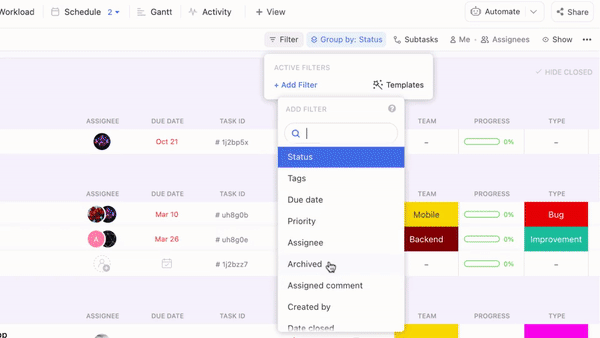
حدد النقاط المهمة في مشروعك بسهولة باستخدام ClickUp Milestones واستخدم الرموز الماسية العريضة للحفاظ على تركيز الجميع على الأهداف الرئيسية
نصيحة احترافية: تصور مدى تقدم المشاريع بين بوابات المراحل باستخدام انقر فوق المعالم الرئيسية لإبقاء الجميع على نفس الصفحة. فهي تساعدك على تصور كيفية ارتباط المهام المختلفة بأهداف المشروع ويمكن عرضها من لوحات المعلومات أو طريقة عرض جانت أو طريقة عرض اللوحة.
### 4. تخطيط المشروع
في مرحلة تخطيط المشروع، تبدأ في تشكيل مشروعك وتحديد العمل الذي يجب القيام به ومتى.
تخطيط المشروع هو عملية مفصلة قد تتضمن أشياء مثل:
- إنشاء مهام المشروع والمهام الفرعية
- إسناد المسؤوليات والأدوار والمهام لكل عضو من أعضاء الفريق
- إنشاء تواريخ استحقاق لكل مهمة ومهمة فرعية
- جدولة عمليات التحقق المنتظمة لمراقبة التقدم المحرز بين بوابات المراحل
- مراجعة وتحسينتوحيد العملية لضمان كفاءة العمليات وإنتاجيتها
تأكد من التحقق مع أعضاء الفريق بشكل فردي للتأكد من أن الجميع على دراية بأهداف المشروع وأن لا أحد يتولى عملاً أكثر مما يستطيع إدارته. ستحتاج أيضًا إلى وضع خطة لمراقبة إنجاز مهام كل عضو من أعضاء الفريق لتحديد وتجنب الاختناقات مع تقدم المشروع.

يمكنك الإشراف على المهام والمشاريع في لمحة واحدة وسحب المهام وإفلاتها وفرزها وتصفيتها دون عناء باستخدام طريقة عرض لوحة كانبان القابلة للتخصيص بالكامل
نصيحة احترافية: استخدم أدوات إدارة المشاريع لإدارة سير عمل فريقك وإعداد الأتمتة للمهام اليومية. توفر العديد من الأدوات أيضًا قوالب إدارة المشاريع لجعل إنشاء أشياء مثل مخططات جانت ولوحات كانبان أسهل.
5. مشروع قيد التنفيذ
مرحلة المشروع قيد التنفيذ هي المرحلة التي يبدأ فيها التنفيذ. لقد حان الوقت ليبدأ فريقك في العمل على المهام وإنجازها لتقريب المشروع من الاكتمال كل يوم.
هذه مرحلة عالية الضغط تتضمن أشياء مثل:
- تحديثات في الوقت الفعلي حول تقدم المهام والمهام الفرعية
- اجتماعات منتظمة للفريق لإبقاء الجميع على نفس الصفحة
- تحديثات حول تواريخ إنجاز المهام وغيرها من تقديرات الجدول الزمني للمشروع
- قياس مؤشرات الأداء الرئيسية وتتبع أداء المشروع
- إنشاء تقارير مرحلية لمشاركتها مع أصحاب المصلحة 📈
- تحديد وحل الاختناقات وغيرها من مجالات المشاكل المحتملة الأخرى
هذه هي المرحلة الأكثر استهلاكاً للوقت. اعتمادًا على عدد أهداف المشروع، قد يستغرق الأمر شهورًا أو سنوات قبل الانتقال إلى المرحلة التالية.

قم بتقسيم الأهداف والمهام والنقاط الرشيقة وحالات المشروع في لوحة معلومات ClickUp 3.0 القابلة للتخصيص بدرجة كبيرة
نصيحة احترافية: استخدم لوحة تحكم ClickUp كمركز التحكم في مهمة مشروعك. مع توفر أكثر من 50 عنصر واجهة مستخدم، ستتمكن من تتبع الأهداف، ومراقبة المقاييس الرئيسية، ومراقبة التقدم المحرز في الوقت الفعلي، وغير ذلك الكثير.
6. المشاريع المكتملة
هذه المرحلة لا تحتاج إلى شرح - تم الانتهاء من المشروع وتسليمه، وهو حان وقت الاحتفال ! 🥳🏆
بعد الاحتفال بنجاح مشروعك، حان الوقت لتقييم كيف سارت الأمور. بصفتك مدير المشروع، يمكنك قيادة أعضاء الفريق في مناقشة حول مواضيع مثل
- نتائج المشروع
- أداء الفريق
- المشاكل والعقبات
يتيح لك ذلك معرفة أين يمكن أن يكون أداؤك أفضل في المشروع لإفادة المشاريع المستقبلية.
قد ترغب أيضًا في مراجعة نقاط القوة والضعف لدى كل عضو من أعضاء الفريق في اجتماعات إكمال المشروع الفردية.
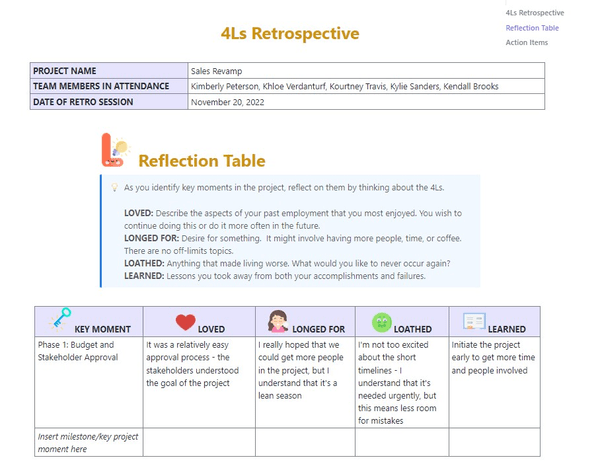
قم بإعادة تنشيط فريقك من خلال قالب المستند الإبداعي الخاص بنا لتشجيع أعضاء الفريق على التعمق في رؤى مشروعهم
نصيحة احترافية: اجعل جلسات فريق مشروعك الاستعراضية أكثر جاذبية باستخدام تقنية 4Ls - التي ترمز إلى "أحببت" و"اشتقت" و"كرهت" و"تعلمت" قالب كليك أب 4Ls الرجعيّ من ClickUp يجعل من السهل على فريقك التفكير في النتائج الرئيسية التي يمكن تطبيقها على المشاريع المستقبلية وتلخيصها.
## إدارة محفظة المشاريع مقابل إدارة مشاريع المشاريع قيد التنفيذ إدارة محفظة المشاريع يشير إلى إدارة المجموعة الكاملة من المشاريع (أو محفظة المشاريع) التي يجري تنفيذها لفريق أو شركة ما. وقد تشمل:
- تحديد أولويات المشاريع
- مراقبة المشاريع قيد التنفيذ
- قياس الأداء عبر المحفظة
- النظر في الأهداف طويلة الأجل
يختلف هذا الأمر عن إدارة المشاريع قيد التنفيذ، والتي تركز على العصف الذهني واختيار المشاريع المحتملة قبل البدء بها. ثم تصبح المشاريع التي يتم اختيارها للمضي قدماً جزءاً من محفظة المشاريع.
أفضل الممارسات لـ الإدارة الفعالة لخطوط سير المشاريع
تم تصميم أفضل الممارسات هذه لضمان سير العمل بسلاسة أثناء تحديد المشاريع وتقييمها واختيارها ومتابعتها. تختلف كل مؤسسة عن الأخرى، لذلك لا تتردد في تكييف أفضل الممارسات هذه وفقًا لاحتياجاتك الخاصة أو الإضافة إليها أثناء تعلمك ونموك وابتكارك.
التركيز على تحسين الموارد
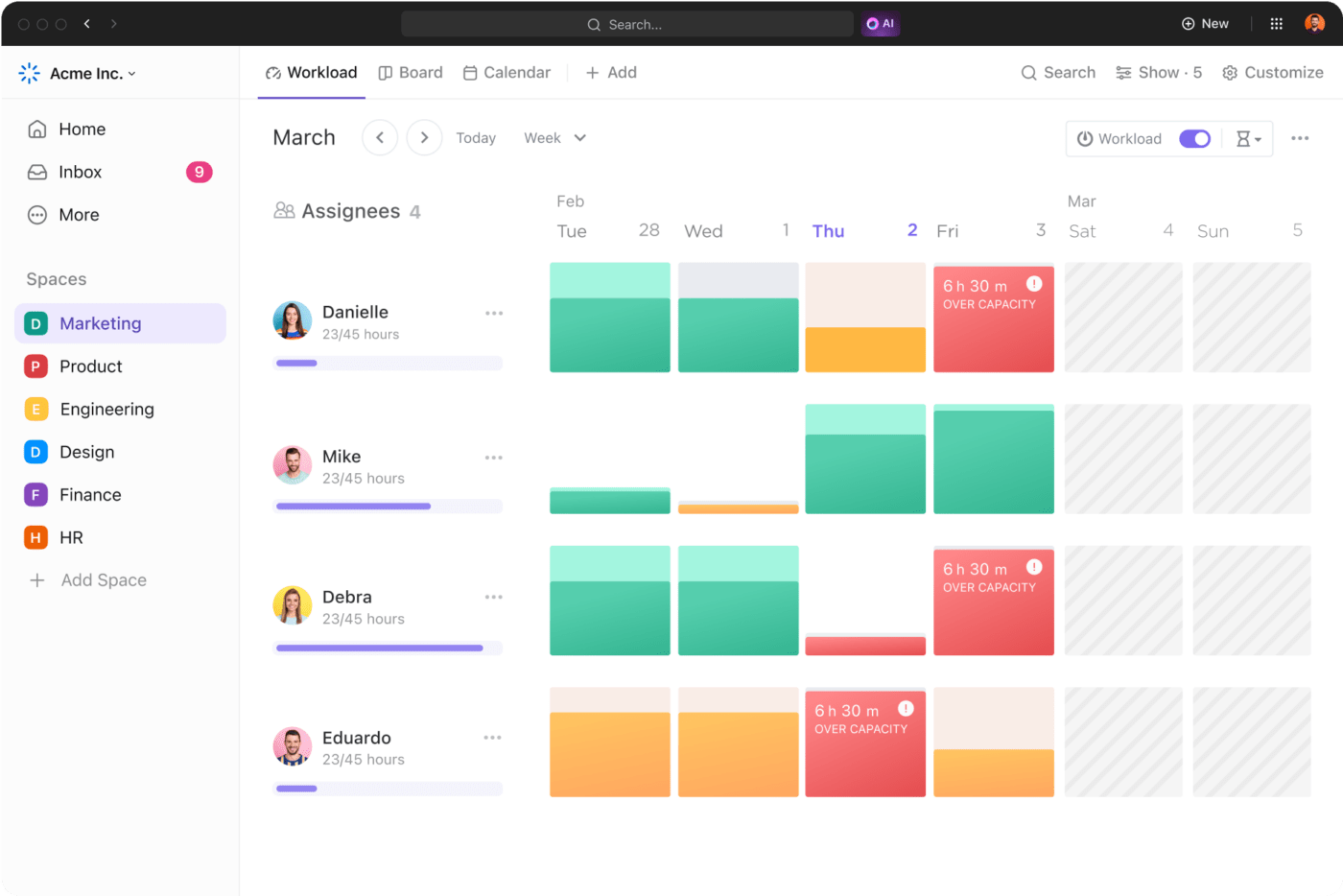
اطلع على أعباء عمل الفريق في لمحة سريعة لتفويض المهام أو إعادة تعيينها بشكل أفضل وفهم بسرعة من هو أقل أو أكثر من طاقته
تخصيص الموارد بكفاءة لتعظيم قيمة كل مشروع. تشمل الموارد التي يجب مراعاتها بشكل عام الميزانية والقوى العاملة والمواد.
تبني منهجيات رشيقة
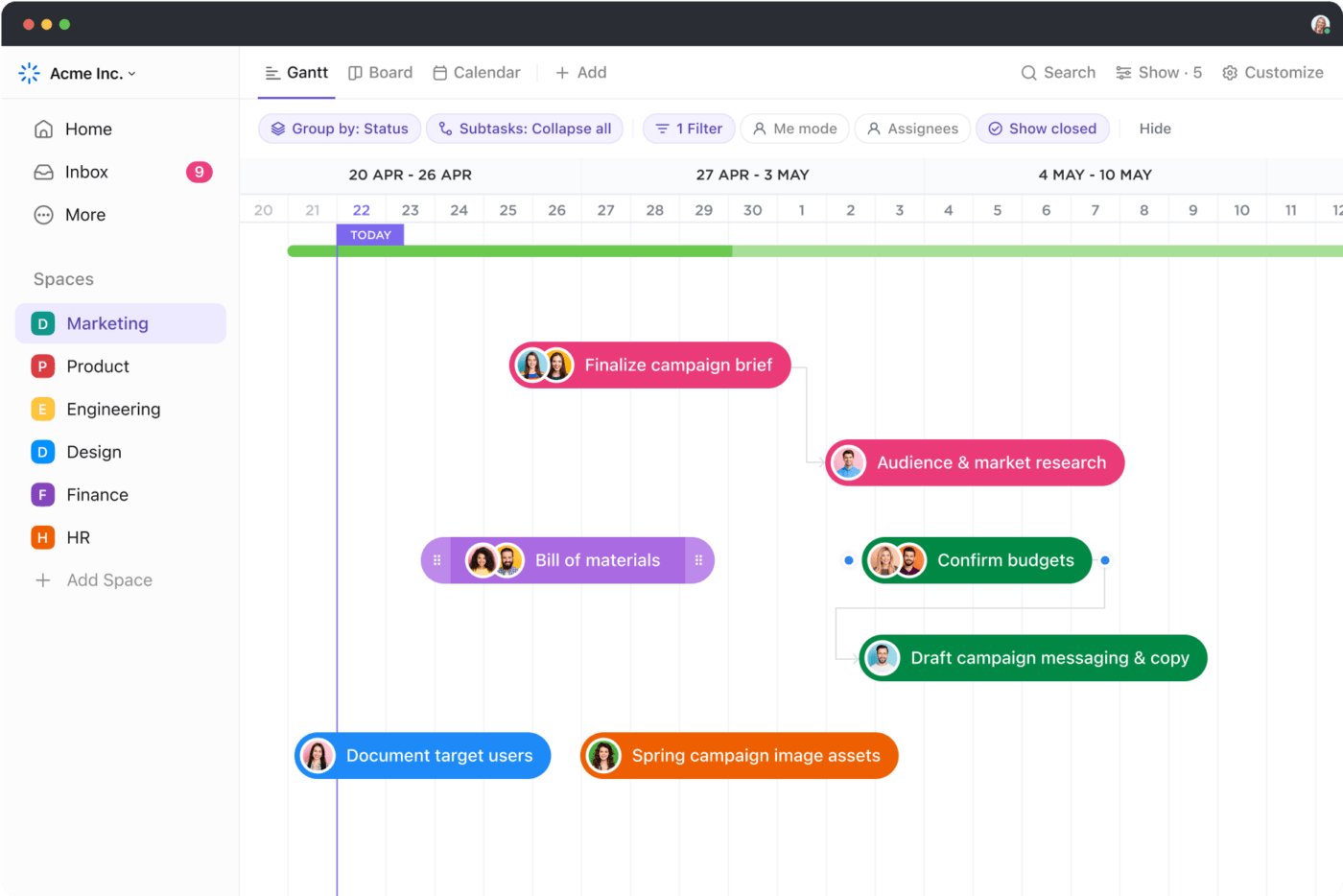
قم بتجميع المهام أو تصفيتها أو إخفائها في مخططات جانت ClickUp 3.0 لتتبع سير العمل وربطه عبر جميع أعمالك إدارة المشاريع الرشيقة مرنة وتمكن فريقك من الاستجابة بسرعة للتغييرات مع تقدم المشروع. يمكنك تنفيذ لوحات كانبان ومخططات جانت ومنهجيات أجايل الأخرى. ثم قارن النتائج بالمشاريع التي تمت معالجتها دون التركيز على الأجايل.
تحديد أولويات المشاريع بوضوح

تعيين أولوية المهمة بسرعة داخل مهمة ما لتوصيل ما يحتاج إلى الاهتمام أولاً
يمكن أن يؤدي وضع معايير مباشرة لتحديد أولويات المشروع إلى توفير الوقت والموارد عند التعامل مع إدارة خط أنابيب المبيعات. ضع في اعتبارك أموراً مثل توافر الموارد، والعائد المحتمل على الاستثمار، وتوقعات خط أنابيب المبيعات، والمواءمة التنظيمية.
مراجعة المشاريع بانتظام
يمكن أن يساعد التقييم المستمر الفرق على التكيف مع الظروف والاحتياجات والأولويات التنظيمية المتغيرة. قم بمراجعة المشاريع الحالية والمحتملة والمستقبلية وإعادة تقييمها بانتظام للتأكد من أنك تضع تركيزك في المكان المناسب.
إشراك أصحاب المصلحة
يساعد تعزيز التواصل الشفاف مع أصحاب المصلحة على ضمان التوافق مع احتياجاتهم وتوقعاتهم. كما يحافظ التواصل الواضح على إبقاء أصحاب المصلحة على اطلاع ومشاركة طوال دورة حياة المشروع.
كن استباقيًا في إدارة المخاطر
قم بإجراء مراجعات منتظمة لتحديد مخاطر المشروع والتخفيف من حدتها حتى تتمكن من الحد من الاضطرابات. وهذا أمر ضروري من أجل إدارة مشروع التسويق وغيرها من المشاريع التي تتطلب أوقات استجابة شبه فورية للمخاطر لتقليل الخسائر.
الاعتماد على البيانات اتخاذ القرارات
أسس القرارات على مؤشرات الأداء الرئيسية وغيرها من البيانات الموثوقة التي تقيس نجاح المشروع. قد يشمل ذلك تقارير من فريق المبيعات ومعدلات إنجاز المهام في الوقت المحدد وقدرة الموارد وتباين الميزانية وغير ذلك.
تعزيز التعاون متعدد الوظائف

اجمع اتصالات الفريق معًا في مساحة واحدة مع ClickUp Chat وشارك التحديثات واربط الموارد وتعاون دون عناء
نفذ استراتيجيات وتطبيقات لتشجيع التواصل والعمل الجماعي بين الفرق والأقسام. قد يعني ذلك اختيار برنامج لإدارة المشاريع أو إدارة علاقات العملاء مفيد لكل قسم، أو جدولة اجتماعات المتابعة اليومية، أو أي شيء آخر. 🤝
التأكيد على التحسين المستمر
إن تعزيز ثقافة التحسين المستمر يشجع أعضاء فريقك على التعلم من أخطائهم والتركيز على كل مشروع. ركز على التعلم من المشاريع السابقة، وتطبيق أفضل الممارسات، وتسجيل الدروس المستفادة، والعصف الذهني مع أعضاء الفريق لتحديد نقاط الضعف التنظيمية.
استخدم برنامج إدارة المشاريع
توفر برمجيات إدارة المشاريع رؤية مركزية للجداول الزمنية للمشاريع وحالاتها وتخصيص الموارد، مما يبسط إدارة المشاريع بشكل لا يمكن تصديقه.
يمكن لأداة إدارة المشروع الصحيحة تسهيل التعاون وتحسين عملية اتخاذ القرار وتعزيز العلاقات مع أصحاب المصلحة وتحسين سير عمل فريقك.
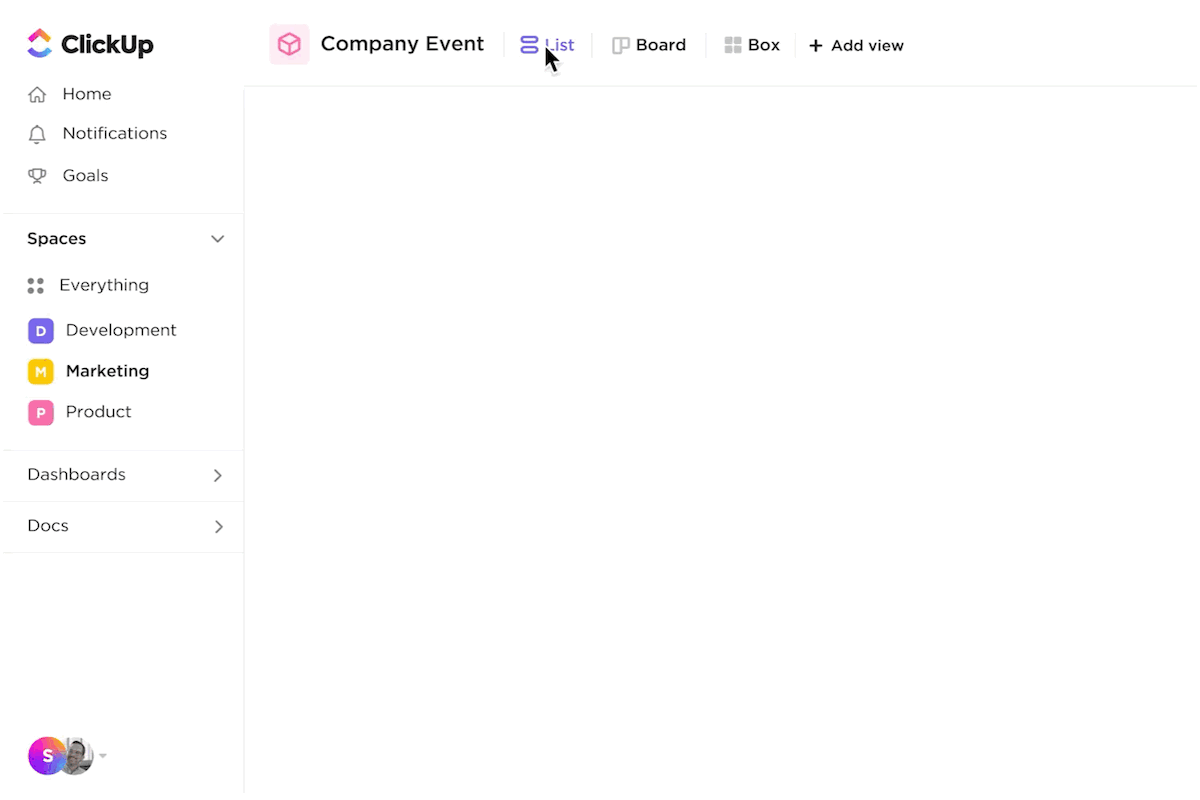
عزز الإنتاجية من خلال تبسيط المهام واستخدام طرق عرض ClickUp القابلة للتكيف لتنظيم جميع أنواع العمل ومراقبتها ClickUp لإدارة المشاريع أفضل برنامج لإدارة المشاريع وكل خطوة من خطوات عملية إدارة المشروع. فهو يحتوي على مجموعة شاملة من الميزات، بما في ذلك حالات المهام القابلة للتخصيص، وعروض المحفظة، والتعاون في الوقت الفعلي، وخيارات التكامل السلس.
صُمم ClickUp لمساعدتك على مراقبة تقدم المشروع عن كثب، وجمع الملاحظات، وأتمتة العمل اليدوي، وتوفير الوقت في كل زاوية.
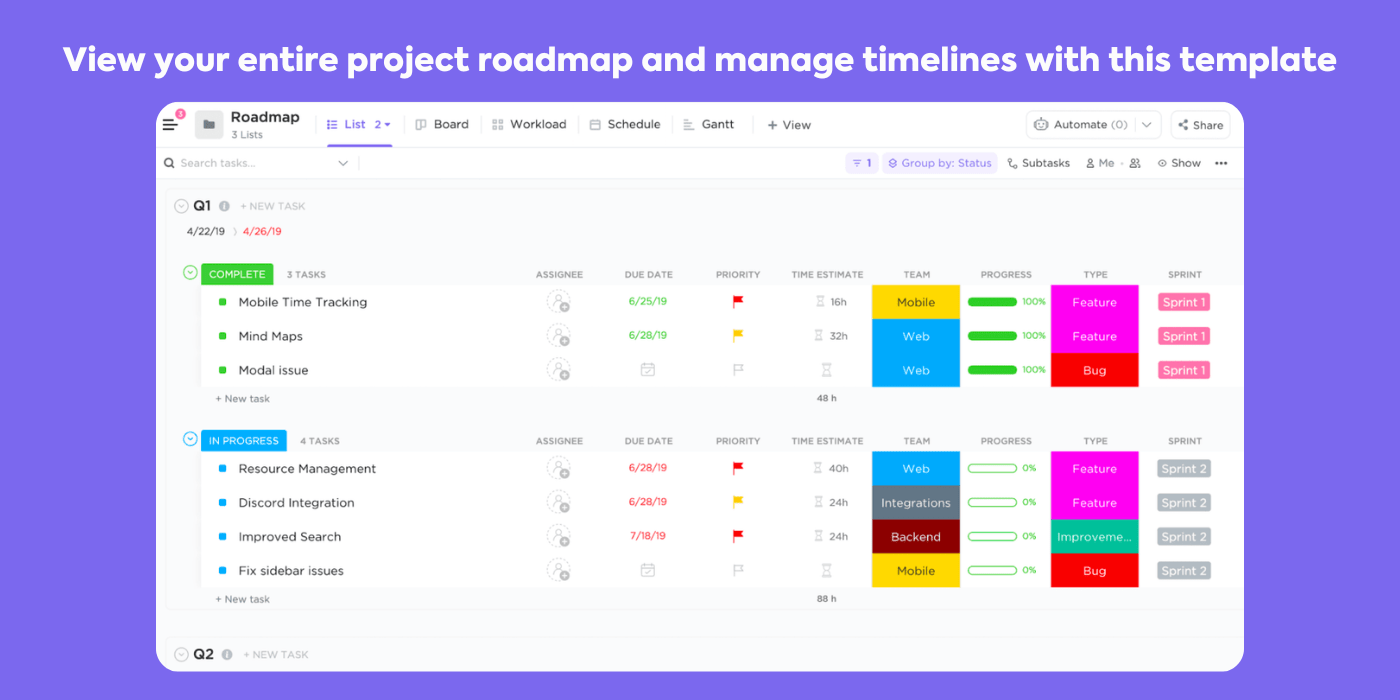
عرض خارطة طريق مشروعك بالكامل وإدارة الجداول الزمنية باستخدام هذا القالب
استخدم قالب خارطة طريق مشروع ClickUp لتتبع جميع الأجزاء المتحركة في مسار إدارة المشروع. إنه مليء بالأدوات التي تحتاجها لضمان نجاح المشروع، وهو واحد فقط من أكثر من 1000 نموذج مصمم لجعل حياتك أسهل.
## أسئلة شائعة
**1. ما هي إدارة مشاريع خطوط الأنابيب؟
إدارة المشاريع قيد التنفيذ هي التخطيط والتنفيذ والمراقبة المنهجية للمشاريع داخل المؤسسة. وهي مصممة لضمان توافق المشاريع مع الأهداف الاستراتيجية أثناء تقدمها من مرحلة التفكير إلى مرحلة الإنجاز.
**2. ما هي مرحلة المشاريع قيد التنفيذ في إدارة المشاريع؟
مرحلة الإعداد في إدارة المشاريع هي مرحلة تحديد المشاريع المحتملة وتقييمها وتحديد أولوياتها وتنفيذها. يتم التعامل مع هذه المرحلة باستخدام أفضل ممارسات إدارة المشاريع قيد التنفيذ حيث يقوم مدير المشروع بتوجيه المشروع خلال كل مرحلة (وضع الأفكار، واستلام العمل، وبوابات المراحل، وتخطيط المشروع، والمشروع قيد التنفيذ، وإنجاز المشروع).
3. ما هي فوائد إدارة المشاريع قيد التنفيذ؟
تشمل فوائد إدارة خط سير المشروع تحسين المواءمة التنظيمية وتحسين الموارد وتحسين عملية صنع القرار. كما أنها تضمن زيادة معدلات نجاح المشروع والكفاءة التنظيمية.
تصبح مديرًا رئيسيًا لخطوط أنابيب المشروع
إن إنشاء خط أنابيب فعال لإدارة المشاريع هو أحد أفضل المشاعر التي يمكنك الاستمتاع بها كمدير مشروع. إنه لأمر مُرضٍ للغاية مشاهدة المشاريع المحسّنة وهي تنتقل من مرحلة التفكير إلى مرحلة الإنجاز.
الإدارة الفعالة لخط سير المشاريع أمر بالغ الأهمية للنجاح المؤسسي. ستضمن المواءمة الاستراتيجية، وتحسين الموارد، والتنفيذ في الوقت المناسب، مما يؤدي إلى دفع الابتكار بفعالية وتأمين ميزة تنافسية. ✨
ClickUp هو أداة لا غنى عنها، حيث يوفر ميزات قوية مصممة خصيصًا لإدارة جميع الأمور المتعلقة بإدارة المشاريع قيد التنفيذ. فهي تُمكِّن المؤسسات من تبسيط سير العمل، وتعزيز التعاون، واتخاذ القرارات المستندة إلى البيانات لزيادة كفاءة ونجاح مبادرات المشاريع.
أوه نعم، وهو مجاني! 🤑
ماذا تنتظر؟ اشترك في ClickUp اليوم

